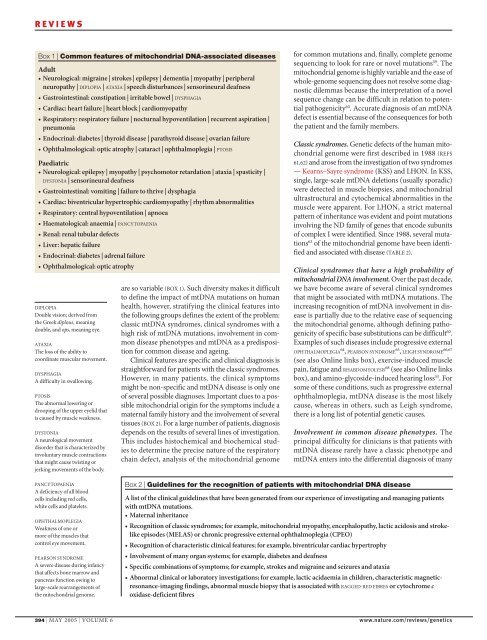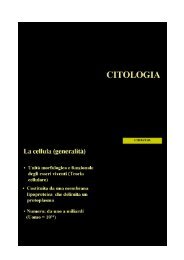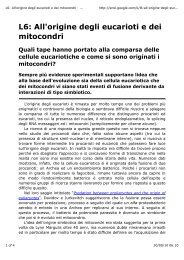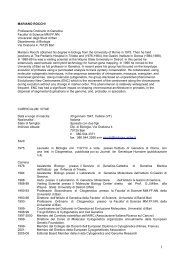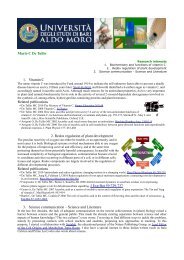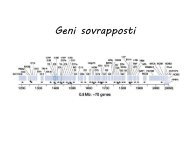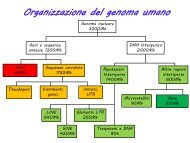mitochondrial dna mutations in human disease - The Rare ...
mitochondrial dna mutations in human disease - The Rare ...
mitochondrial dna mutations in human disease - The Rare ...
Create successful ePaper yourself
Turn your PDF publications into a flip-book with our unique Google optimized e-Paper software.
REVIEWS<br />
Box 1 | Common features of <strong>mitochondrial</strong> DNA-associated <strong>disease</strong>s<br />
Adult<br />
• Neurological: migra<strong>in</strong>e | strokes | epilepsy | dementia | myopathy | peripheral<br />
neuropathy | DIPLOPIA | ATAXIA | speech disturbances | sensor<strong>in</strong>eural deafness<br />
• Gastro<strong>in</strong>test<strong>in</strong>al: constipation | irritable bowel | DYSPHAGIA<br />
• Cardiac: heart failure | heart block | cardiomyopathy<br />
• Respiratory: respiratory failure | nocturnal hypoventilation | recurrent aspiration |<br />
pneumonia<br />
• Endocr<strong>in</strong>al: diabetes | thyroid <strong>disease</strong> | parathyroid <strong>disease</strong> | ovarian failure<br />
• Ophthalmological: optic atrophy | cataract | ophthalmoplegia | PTOSIS<br />
Paediatric<br />
• Neurological: epilepsy | myopathy | psychomotor retardation | ataxia | spasticity |<br />
DYSTONIA | sensor<strong>in</strong>eural deafness<br />
• Gastro<strong>in</strong>test<strong>in</strong>al: vomit<strong>in</strong>g | failure to thrive | dysphagia<br />
• Cardiac: biventricular hypertrophic cardiomyopathy | rhythm abnormalities<br />
• Respiratory: central hypoventilation | apnoea<br />
• Haematological: anaemia | PANCYTOPAENIA<br />
• Renal: renal tubular defects<br />
• Liver: hepatic failure<br />
• Endocr<strong>in</strong>al: diabetes | adrenal failure<br />
• Ophthalmological: optic atrophy<br />
DIPLOPIA<br />
Double vision; derived from<br />
the Greek diplous, mean<strong>in</strong>g<br />
double, and ops, mean<strong>in</strong>g eye.<br />
ATAXIA<br />
<strong>The</strong> loss of the ability to<br />
coord<strong>in</strong>ate muscular movement.<br />
DYSPHAGIA<br />
A difficulty <strong>in</strong> swallow<strong>in</strong>g.<br />
PTOSIS<br />
<strong>The</strong> abnormal lower<strong>in</strong>g or<br />
droop<strong>in</strong>g of the upper eyelid that<br />
is caused by muscle weakness.<br />
DYSTONIA<br />
A neurological movement<br />
disorder that is characterized by<br />
<strong>in</strong>voluntary muscle contractions<br />
that might cause twist<strong>in</strong>g or<br />
jerk<strong>in</strong>g movements of the body.<br />
are so variable (BOX 1). Such diversity makes it difficult<br />
to def<strong>in</strong>e the impact of mtDNA <strong>mutations</strong> on <strong>human</strong><br />
health, however, stratify<strong>in</strong>g the cl<strong>in</strong>ical features <strong>in</strong>to<br />
the follow<strong>in</strong>g groups def<strong>in</strong>es the extent of the problem:<br />
classic mtDNA syndromes, cl<strong>in</strong>ical syndromes with a<br />
high risk of mtDNA <strong>mutations</strong>, <strong>in</strong>volvement <strong>in</strong> common<br />
<strong>disease</strong> phenotypes and mtDNA as a predisposition<br />
for common <strong>disease</strong> and age<strong>in</strong>g.<br />
Cl<strong>in</strong>ical features are specific and cl<strong>in</strong>ical diagnosis is<br />
straightforward for patients with the classic syndromes.<br />
However, <strong>in</strong> many patients, the cl<strong>in</strong>ical symptoms<br />
might be non-specific and mtDNA <strong>disease</strong> is only one<br />
of several possible diagnoses. Important clues to a possible<br />
<strong>mitochondrial</strong> orig<strong>in</strong> for the symptoms <strong>in</strong>clude a<br />
maternal family history and the <strong>in</strong>volvement of several<br />
tissues (BOX 2). For a large number of patients, diagnosis<br />
depends on the results of several l<strong>in</strong>es of <strong>in</strong>vestigation.<br />
This <strong>in</strong>cludes histochemical and biochemical studies<br />
to determ<strong>in</strong>e the precise nature of the respiratory<br />
cha<strong>in</strong> defect, analysis of the <strong>mitochondrial</strong> genome<br />
for common <strong>mutations</strong> and, f<strong>in</strong>ally, complete genome<br />
sequenc<strong>in</strong>g to look for rare or novel <strong>mutations</strong> 59 . <strong>The</strong><br />
<strong>mitochondrial</strong> genome is highly variable and the ease of<br />
whole-genome sequenc<strong>in</strong>g does not resolve some diagnostic<br />
dilemmas because the <strong>in</strong>terpretation of a novel<br />
sequence change can be difficult <strong>in</strong> relation to potential<br />
pathogenicity 60 . Accurate diagnosis of an mtDNA<br />
defect is essential because of the consequences for both<br />
the patient and the family members.<br />
Classic syndromes. Genetic defects of the <strong>human</strong> <strong>mitochondrial</strong><br />
genome were first described <strong>in</strong> 1988 (REFS<br />
61,62) and arose from the <strong>in</strong>vestigation of two syndromes<br />
— Kearns–Sayre syndrome (KSS) and LHON. In KSS,<br />
s<strong>in</strong>gle, large-scale mtDNA deletions (usually sporadic)<br />
were detected <strong>in</strong> muscle biopsies, and <strong>mitochondrial</strong><br />
ultrastructural and cytochemical abnormalities <strong>in</strong> the<br />
muscle were apparent. For LHON, a strict maternal<br />
pattern of <strong>in</strong>heritance was evident and po<strong>in</strong>t <strong>mutations</strong><br />
<strong>in</strong>volv<strong>in</strong>g the ND family of genes that encode subunits<br />
of complex I were identified. S<strong>in</strong>ce 1988, several <strong>mutations</strong><br />
63 of the <strong>mitochondrial</strong> genome have been identified<br />
and associated with <strong>disease</strong> (TABLE 2).<br />
Cl<strong>in</strong>ical syndromes that have a high probability of<br />
<strong>mitochondrial</strong> DNA <strong>in</strong>volvement. Over the past decade,<br />
we have become aware of several cl<strong>in</strong>ical syndromes<br />
that might be associated with mtDNA <strong>mutations</strong>. <strong>The</strong><br />
<strong>in</strong>creas<strong>in</strong>g recognition of mtDNA <strong>in</strong>volvement <strong>in</strong> <strong>disease</strong><br />
is partially due to the relative ease of sequenc<strong>in</strong>g<br />
the <strong>mitochondrial</strong> genome, although def<strong>in</strong><strong>in</strong>g pathogenicity<br />
of specific base substitutions can be difficult 60 .<br />
Examples of such <strong>disease</strong>s <strong>in</strong>clude progressive external<br />
OPHTHALMOPLEGIA 64 , PEARSON SYNDROME 65 , LEIGH SYNDROME 66,67<br />
(see also Onl<strong>in</strong>e l<strong>in</strong>ks box), exercise-<strong>in</strong>duced muscle<br />
pa<strong>in</strong>, fatigue and RHABDOMYOLYSIS 68 (see also Onl<strong>in</strong>e l<strong>in</strong>ks<br />
box), and am<strong>in</strong>o-glycoside-<strong>in</strong>duced hear<strong>in</strong>g loss 55 . For<br />
some of these conditions, such as progressive external<br />
ophthalmoplegia, mtDNA <strong>disease</strong> is the most likely<br />
cause, whereas <strong>in</strong> others, such as Leigh syndrome,<br />
there is a long list of potential genetic causes.<br />
Involvement <strong>in</strong> common <strong>disease</strong> phenotypes. <strong>The</strong><br />
pr<strong>in</strong>cipal difficulty for cl<strong>in</strong>icians is that patients with<br />
mtDNA <strong>disease</strong> rarely have a classic phenotype and<br />
mtDNA enters <strong>in</strong>to the differential diagnosis of many<br />
PANCYTOPAENIA<br />
A deficiency of all blood<br />
cells <strong>in</strong>clud<strong>in</strong>g red cells,<br />
white cells and platelets.<br />
OPHTHALMOPLEGIA<br />
Weakness of one or<br />
more of the muscles that<br />
control eye movement.<br />
PEARSON SYNDROME<br />
A severe <strong>disease</strong> dur<strong>in</strong>g <strong>in</strong>fancy<br />
that affects bone marrow and<br />
pancreas function ow<strong>in</strong>g to<br />
large-scale rearrangements of<br />
the <strong>mitochondrial</strong> genome.<br />
Box 2 | Guidel<strong>in</strong>es for the recognition of patients with <strong>mitochondrial</strong> DNA <strong>disease</strong><br />
A list of the cl<strong>in</strong>ical guidel<strong>in</strong>es that have been generated from our experience of <strong>in</strong>vestigat<strong>in</strong>g and manag<strong>in</strong>g patients<br />
with mtDNA <strong>mutations</strong>.<br />
• Maternal <strong>in</strong>heritance<br />
• Recognition of classic syndromes; for example, <strong>mitochondrial</strong> myopathy, encephalopathy, lactic acidosis and strokelike<br />
episodes (MELAS) or chronic progressive external ophthalmoplegia (CPEO)<br />
• Recognition of characteristic cl<strong>in</strong>ical features; for example, biventricular cardiac hypertrophy<br />
• Involvement of many organ systems; for example, diabetes and deafness<br />
• Specific comb<strong>in</strong>ations of symptoms; for example, strokes and migra<strong>in</strong>e and seizures and ataxia<br />
• Abnormal cl<strong>in</strong>ical or laboratory <strong>in</strong>vestigations; for example, lactic acidaemia <strong>in</strong> children, characteristic magneticresonance-imag<strong>in</strong>g<br />
f<strong>in</strong>d<strong>in</strong>gs, abnormal muscle biopsy that is associated with RAGGED-RED FIBRES or cytochrome c<br />
oxidase-deficient fibres<br />
394 | MAY 2005 | VOLUME 6 www.nature.com/reviews/genetics<br />
© 2005 Nature Publish<strong>in</strong>g Group


